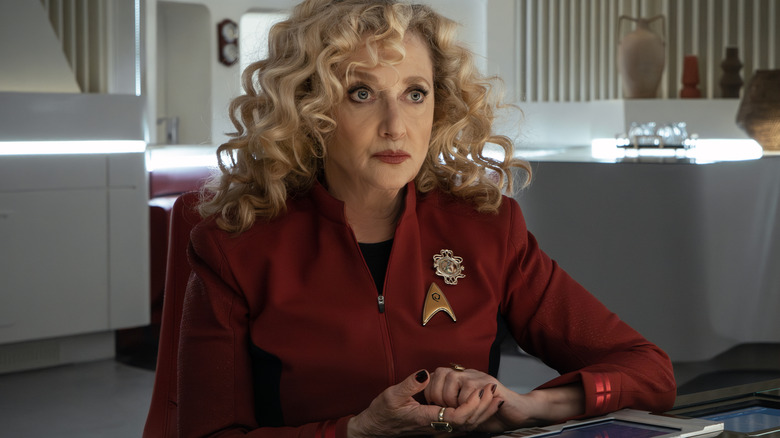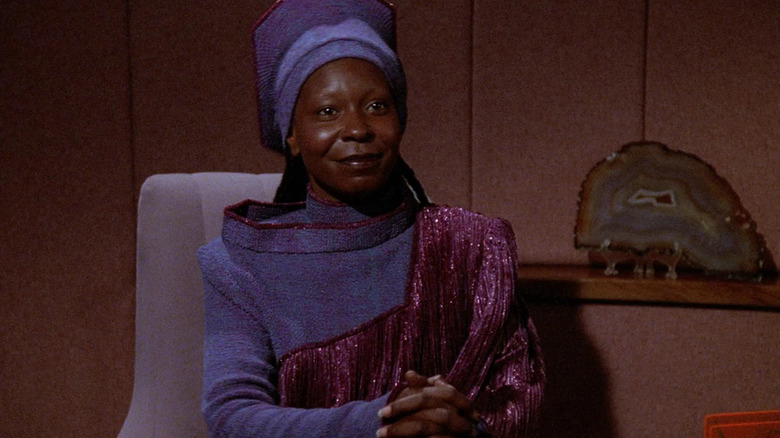What Are Lathanites In Star Trek? The Species Explained
In the second season of "Star Trek: Strange New Worlds," the U.S.S. Enterprise needed a new chief engineer. The ship's previous engineer, Hemmer (Bruce Horak), was killed in a conflagration with the Gorn, and the ship was sad to lose his skill. Luckily, Captain Pike (Anson Mount) happened upon Pelia (Carol Kane), an eccentric, rules-averse gearhead with many years of experience. Indeed, when Pelia speaks in front of the language expert Uhura (Celia Rose-Gooding), her accent is identified as Lanthanite, a human-looking species that just happens to live many thousands of years.
Lanthanites hadn't been seen on "Star Trek" before, so Pelia's inclusion was a fun new addition to the franchise. As "Strange New Worlds" progressed, Trekkies learned that Lanthanites tend to be packrats, accumulating souvenirs from countless centuries of travel. There series also, thanks to a time travel widget, visited Pelia in the 21st century (in the episode "Tomorrow and Tomorrow and Tomorrow"), and she looked exactly the same, not having aged a day in 200 years. She also noted in that same episode that she was alive at the same time as Pythagoras, who died around 490 BCE. "Strange New Worlds" takes place in the late 2250s and early 2260s, meaning Pelia is at the very least 2,750 years old. She is, however, likely much older.
Apart from these scant details, though, what else have we learned about Lanthanites so far? Because we Trekkies are a thorough lot, there is a lot that can be shared based on dialogue from the second season of "Strange New Worlds."
Pelia from Star Trek: Strange New Worlds is the only Lanthanite we've met
The most notable details about Lanthanites are, as mentioned, their accents and their longevity. Because of the accent, /Film has theorized/joked that Pelia is actually the same character that Kane played in the sitcom "Taxi," although that is clearly unsubstantiated. In the episode "The Broken Circle" (June 15, 2023), Lanthanites are said to be able to live "almost forever." Pelia complained that her longevity was a source of some melancholy. Not because she watched friends die of old age (most of her compatriots seem to be of shorter-lived species), as that can become a predictable cycle. The most horrid thing about living thousands of years is the boredom.
Spock (Ethan Peck) remarks that Lanthanites were discovered by humans in the 22nd century, although they had been hiding out among humans for many millennia prior (see: the Pythagoras comment above). One might begin to idly speculate that the Lanthanites actually originated on Earth, and merely evolved alongside humans. Given the way Pelia talks about Earth and humans, however, it seems clear that she was a visitor to our planet.
Lanthanites, being a new addition to the "Star Trek" universe, haven't yet had the chance to appear in any expanded universe lore, novels, movies, or additional "Trek" media beyond "Strange New Worlds." Pelia is the only one so far. One might infer from this that Lanthanites are rare and don't reproduce often. Or that they secretive and keep their species hidden. This is easy to do because they look exactly like humans. As far as we know, Lanthanites simply age slowly, and don't have miraculous healing powers like Wolverine. A Lathanite can die in an accident or by violence. It makes sense, though, that a species as long-lived as Lanthanites would eschew violence. I would imagine war doesn't exist on their homeworld.
We've met plenty of other long-lived species on Star Trek
Of course, Lanthanies aren't the only species on "Star Trek" that lives significantly longer than humans. On "Star Trek: The Next Generation," Captain Picard (Patrick Stewart) was able to meet the elderly Vulcan Spock (Leonard Nimoy) who had simply gone on living since the original "Star Trek" series. Vulcans, we learn, can live over 200 years, if they take care of themselves (and it's logical to take care of yourself). Spock's father, Sarek (Mark Lenard) lived to be 203.
Then there's the Denobulans from "Star Trek: Enterprise." It's implied that Denobulans — the species of Dr. Phlox (John Billingsley) — can live over 300 years, as the good doctor's grandmother lived through several vicious wars from that long ago.
On "Star Trek: Deep Space Nine," Dax (Terry Farrell) was a Trill, and they have incredibly long-lives. Sort of. The Trill is a conjoining of two species, a humanoid host and a worm-like entity that is surgically implanted in their abdomen. The worm entity can live about 550 years, but has to move between its hosts, which can only live for about 80 to 100. Dax is 20, but also 357.
Also on "Next Generation," audiences met Guinan (Whoopi Goldberg), a member of the El Aurian species. El Aurians look like humans, have a very mellow life philosophy, and can live many centuries. Guinan was an adult on Earth in 1893 and used to tool around with Mark Twain (Jerry Hardin). Guinan, then, was at least 490. She also once mentioned that her father was still alive, and that he was 700. Guinan, being a private person, has never revealed how long El Aurians can live.
In the original "Star Trek" episode "Let That Be Your Last Battlefield" (January 10, 1969) two characters name Bele and Lokai (Frank Gorshin and Lou Antonio), from the planet Charon, claimed to have been hunting one another for 50,000 years. Happy birthday!
And that's not even counting magnetic organisms or godlike entities that can live for millions of years. "Star Trek" operates on quite a long timeline.


